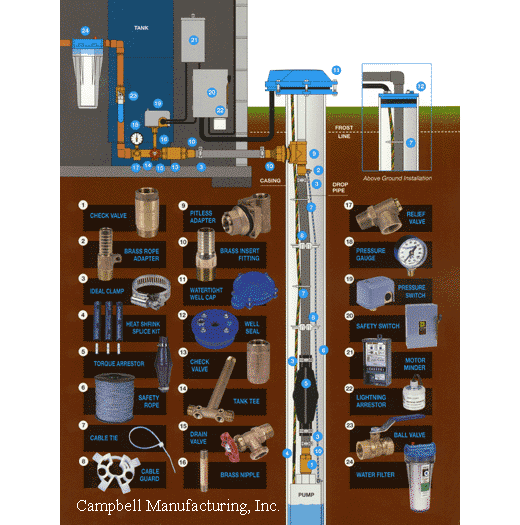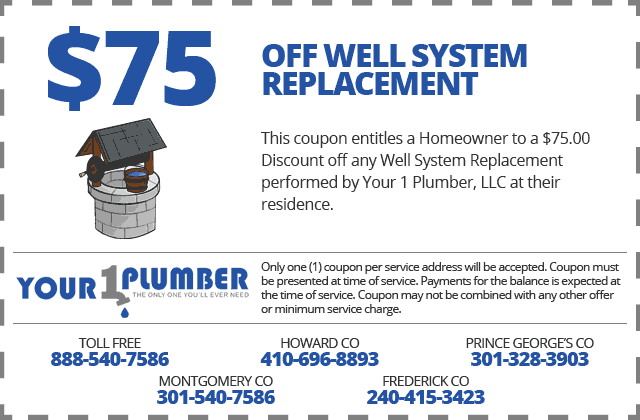WELL SYSTEMS
FORTY-SEVEN PERCENT OF THE US POPULATION DEPENDS ON GROUNDWATER FOR ITS DRINKING WATER SUPPLY.
Your 1 Plumber is committed to providing water softeners & filtration and well system services to ensure your drinking water is clean, safe, and healthy.
Your 1 Plumber is committed to providing water softeners & filtration and well system services to ensure your drinking water is clean, safe, and healthy.
Many of that number that depend on ground water require a private well. If you are a water well system owner, or are thinking about getting a system for your family’s drinking water needs, it is important that you have a basic understanding about the different materials that comprise the system.
Below is information about casing, well caps, well screens, and pitless adapters: basic materials that combine with a pump to provide water for a household.
WELL CASINGS
Casing is the tubular structure that is placed in the drilled well to maintain the well opening. Along with grout, the casing also confines the ground water to its zone underground and prevents contaminants from mixing with the water. Some states or local governing agencies have laws that require minimum lengths for casing.
The most common materials for well casing are carbon steel, plastic (most commonly, but not exclusively, PVC), and stainless steel. Different geologic formations dictate what type of casing can be used. For example, parts of the country where hard rock lies underground are known strictly as “steel states.”
Residents in some areas have a choice between steel and PVC, both of which have advantages. PVC is lightweight, resistant to corrosion, and relatively easy for contractors to install. However, it is not as strong and not as resistant to heat as steel. Steel, though, is susceptible to corrosion, can have scale build-up, and can cost more than PVC.
Some contractors also use concrete, fiberglass, and asbestos cement casing.
QUICK CONTACT
NO OBLIGATION
Contact us or give us a call to discover how we can help.


WELL CAPS
On the top of the casing should be an approved well cap. It should fit snugly so debris, insects, or small animals can’t find their way into the well system.
Well caps are usually aluminum or a thermoplastic, and include a vented screen so that the pressure difference between the inside and outside of the well casing may be equalized when water is pumped from the well.
The casing and cap should extend at least 6 to 8 inches above the ground. If the well is near a river or stream, it should extend at least past the flood level to prevent overflows from contaminating the ground water.
WELL SCREENS
Well screens are filtering devices used to prevent excess sediment from entering the well. They attach to the bottom of the casing, allowing water to move through the well, while keeping out most gravel and sand. The most popular screens are continuous slot, slotted pipe, and perforated pipe.
Perforated pipe is a length of casing that has holes or slots drilled into the pipe. It is not efficient for aquifers that feature a lot of sand and gravel because it has wide openings.
There is less open area in the other two types of screens. Continuous slot screens are made of wire or plastic wrapped around a series of vertical rods. Slotted pipe screens, which have the least amount of open area, feature machine-cut slots into steel or plastic casing at set distances.
PITLESS ADAPTERS
Pitless adapters provide wells with a sanitary — and frost-proof — seal between the well casing and the water line running to the well system owner’s house.
After a frost line is determined for the area where the well is being installed, the adapter is connected to the well casing below the frost line. Water from the well is then diverted horizontally at the adapter to prevent it from freezing.
WELL SYSTEM OVERVIEW

- Check Valve: Located at the top of the pump, it prevents backflow into the pump and holds the head of water in the system.
- Brass Rope Adapter: Connects the Pitless Adapter and the Submersible PUmp with Safety Rope.
- IDEAL Clamps: All stainless-steel clamps for dependable connections between pipe and Insert Fittings or Torque Arrestor.
- Heat Shrink Splice Kit: For waterproof electric cable splices in submersible pump installations.
- Torque Arrestor: Installed directly above submersible pump to protect pump and well components from starting torque damage.
- Safety Rope: A safety line from the top of the well to the pump.
- Cable Tie: Fastens cable to the Drop Pipe.
- Cable Guard: Protects submersible cable wires from abrading against sides of well. Two styles available: self-clamping or snap-in.
- Pitless Adapter: Provides a watertight, sanitary, removable connection between the pump and the house. Installed in the casing below the frost line to prevent freezing.
- Brass Insert Fitting: Provides a connection between poly pipe and pipe thread of Pitless Adapter.
- Watertight Well Cap: Inner gasket compresses to outside diameter of casing to provide a watertight seal. Top of cap removes easily to access well for service.
- Well Seal: Used in above-ground installation to provide a positive seal inside casing.
- Check Valve: Installed near the tank inlet to hold water in the tank when the pump is idle.
- Tank Tee: Connects water line from pump to pressure tank and service line from tank to house. Taps are provided to accept Pressure Switch, Pressure Gauge, Drain Valve, Relief Valve, Snifter Valve, etc.
- Drain Valve: For easy draining of the system.
- Brass Nipple: Male threads allow attachment of Pressure Switch to Tank Tee.
- Relief Valve: Protects against pressure buildup. Should be used on any system where the pump could develop greater pressure than the maximum rating of the system.
- Pressure Gauge: Measures water pressure in Pressure Tank.
- Pressure Switch: Signals the pump to start when the water system drops to a preset low pressure, and to stop when the high pressure mark is reached.
- SQUARE D Safety Switch: For electric control and distribution of the pump.
- Motor Minder: Adjustable, solid state control that monitors system load conditions to protect pump motor from dry well, loss of flow, rapid cycling, slow recovers, air lock, and locked rotor problems.
- Lightning Arrestor: Protects pump motor and controls from voltage surges caused by lightning, switch loads, and power line interference.
- Ball Valve: Acts as a shutoff valve on the supply line from the tank to the house.
- Water Filter: A point-of-entry, whole-house filter that removes rust particles, sand, etc. from supply water.

